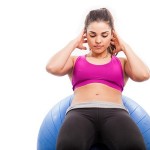 Protect Your Neck While Exercising
Protect Your Neck While Exercising
Exercising is great for your body when performed with the correct body mechanics and posturing. The problem is, whether you work out at home or in a gym setting, you likely don’t have a clue what you look like when you’re exercising. Even people who use personal trainers are often injured because while a trainer knows how to improve your physical strength and agility, they are not educated in preventing physical injury related to potentially damaging body postures.
Each week, while I work out at the gym, I find I must turn my eyes away from “injuries in the making”. It’s just too (potentially) painful to watch! For this reason I want to address one common “postural crime” we are all prone to commit, whether you are in a Pilates or Crossfit® class or simply lifting weights on your own or under the semi-watchful (but unaware) eye of a trainer.
The “postural crime” that I speak of is an unprotected neck. The neck is a made up of a stack of seven bones strung together loosely by a whole slew of muscles. Our Creator fabricated it in this way so that we could have ample mobility to look up, down, and all around us. But the neck can be made to become a far more stable structure in order to protect the vulnerable discs which lie stacked in between nearly every neck bone. The secret to neck safety is so simple…yet rarely ever employed. All that is required is a chin tuck, or a gentle nod of the chin towards the throat. This small, seemingly insignificant movement activates a very important muscle called the longus cervicis whose job it is to cinch together the individual bones of the neck and create a rigid lever out of a bag of bones, if you will.
So before you lift your head off the floor to perform an abdominal exercise or begin to push or pull a weight with your arms or legs, simply nod your head forward, tucking your chin gently towards your throat. THEN you will be safe to exercise without placing undue stress and strain on the discs and joints of your neck.